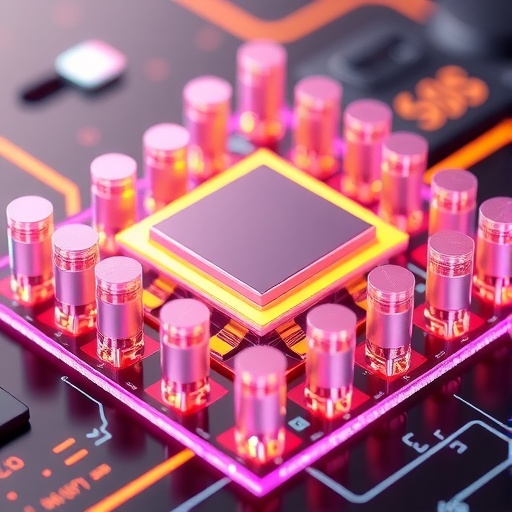In the realm of semiconductor technology, a transformative shift is being observed with the introduction of two-dimensional (2D) transistors. These devices, heralded for their potential to revolutionize integrated circuit design, have garnered significant attention from the scientific community. Their unique properties, such as high electron mobility and reduced dimensionality, pave the way for unprecedented advancements in electronics. At the forefront of this research is a recent study by Chen, Han, and Zhou, published in Nature Electronics, which explores the scaling of contacted poly pitch in 2D transistors, further elucidating the pathways for enhanced performance and efficiency in future electronic devices.
The concept of poly pitch, the distance between the centers of contacts in a transistor, is critical for defining the performance characteristics of 2D devices. In traditional three-dimensional (3D) transistor architectures, there has been extensive research on scaling dimensions down to the nanometer scale. However, 2D transistors present a unique canvas due to their layered structure, which allows for even tighter packing of electronic components. Chen and colleagues have investigated how these new dimensions can lead to smaller devices with greater functionality, thus setting the stage for more compact and efficient electronic circuits.
Chen, Han, and Zhou’s work delves into the intricate dynamics of 2D materials, such as graphene and transition metal dichalcogenides (TMDs), which exhibit remarkable electrical characteristics. These materials, when engineered into transistor structures, can operate at greater scales of integration while maintaining high performance levels. The study emphasizes that with the continuing miniaturization of electronic components, understanding and manipulating the contacted poly pitch becomes increasingly vital.
One significant finding in their research demonstrates that optimizing the contacted poly pitch can significantly enhance carrier injection efficiency in 2D transistors. By refining the space between contacts, the researchers observed improvements in current drive and reduced subthreshold voltage swings. This optimization not only leads to better device performance but also provides a pathway to lower power consumption—a crucial metric in the quest for more sustainable electronics.
A pivotal point in Chen et al.’s study is their exploration of the trade-offs involved in scaling the contacted poly pitch. While reducing this distance can yield better performance, there are inherent challenges related to increased capacitance and potential short-channel effects that could adversely affect transistor behavior. The authors provide an in-depth analysis of these challenges and propose viable strategies to mitigate them through advanced material selection and innovative design approaches.
This research does not merely contribute theoretical frameworks; it also has practical implications for the future of electronic devices. As industries strive to create more powerful yet efficient chips, the insights gleaned from this study could inspire the development of next-generation technology. For instance, the semiconductor industry can leverage these findings to enhance the functionality of compact devices ranging from smartphones to advanced computing systems, effectively pushing the boundaries of what is currently possible in electronics.
Moreover, as the world continues to lean towards greener technologies, the performance improvements tied to the scaling of contacted poly pitch hold the promise of reducing energy consumption in electronic systems. The move towards low-power electronics is imperative as global energy demands increase, and these innovations could represent a significant step forward in sustainable technology.
The ability of researchers to harness the unique properties of 2D materials to create high-performance transistors stands as a testament to the ongoing innovations within the field. This publication sheds light on a crucial aspect of 2D semiconductor research and opens up further avenues for exploration in device architecture and material science. The future landscape of electronics is thus set to be molded significantly by these advancements, potentially leading to a new era of ultra-compact, efficient, and sustainable electronic devices.
As industries and academia continue to converge in exploring these frontiers, the interplay between fundamental research and practical applications will remain a primary focus. Chen et al.’s findings should inspire future collaborations aimed at pushing the limits of semiconductor technology, prompting researchers to ask critical questions and challenge existing paradigms. What implications will this research have for real-world applications? How will industries adapt to the evolving landscape of electronics grounded in these principles?
In conclusion, the exploration of contacted poly pitch scaling in 2D transistors not only enriches academic literature but also heralds an era where electronic devices can become more capable and energy-efficient than ever before. As researchers like Chen, Han, and Zhou lead the charge, the combined potential of innovation, collaboration, and advanced materials is likely to drive the next wave of transformative changes in the electronics industry, shaping the technology we rely on every day.
Subject of Research: Scaling the contacted poly pitch of 2D transistors.
Article Title: Scaling the contacted poly pitch of 2D transistors.
Article References:
Chen, X., Han, ST. & Zhou, Y. Scaling the contacted poly pitch of 2D transistors.
Nat Electron 8, 378–379 (2025). https://doi.org/10.1038/s41928-025-01383-5
Image Credits: AI Generated
DOI: https://doi.org/10.1038/s41928-025-01383-5
Keywords: 2D transistors, poly pitch, semiconductor technology, graphene, transition metal dichalcogenides, electrical characteristics, device performance, low-power electronics, sustainable technology.
Tags: 2D transistors technologycompact electronic device developmentefficiency improvements in electronic circuitsfuture of nanometer scale electronicshigh electron mobility transistorsintegrated circuit design innovationslayered structure of 2D devicesNature Electronics publication highlightsperformance enhancement in transistorspoly pitch scaling in electronicssemiconductor research advancementstransformative semiconductor architectures





